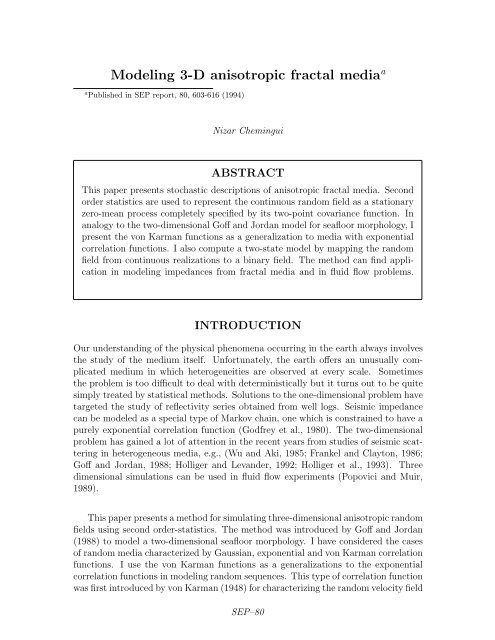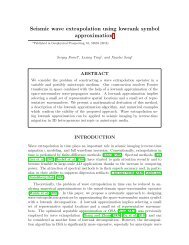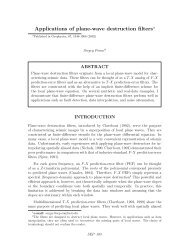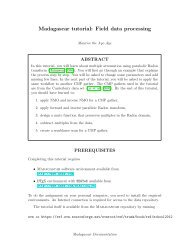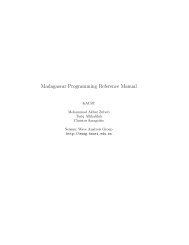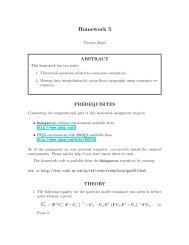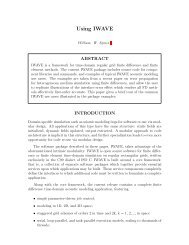Modeling 3-D anisotropic fractal mediaa
Modeling 3-D anisotropic fractal mediaa
Modeling 3-D anisotropic fractal mediaa
You also want an ePaper? Increase the reach of your titles
YUMPU automatically turns print PDFs into web optimized ePapers that Google loves.
<strong>Modeling</strong> 3-D <strong>anisotropic</strong> <strong>fractal</strong> media a<br />
a Published in SEP report, 80, 603-616 (1994)<br />
Nizar Chemingui<br />
ABSTRACT<br />
This paper presents stochastic descriptions of <strong>anisotropic</strong> <strong>fractal</strong> media. Second<br />
order statistics are used to represent the continuous random field as a stationary<br />
zero-mean process completely specified by its two-point covariance function. In<br />
analogy to the two-dimensional Goff and Jordan model for seafloor morphology, I<br />
present the von Karman functions as a generalization to media with exponential<br />
correlation functions. I also compute a two-state model by mapping the random<br />
field from continuous realizations to a binary field. The method can find application<br />
in modeling impedances from <strong>fractal</strong> media and in fluid flow problems.<br />
INTRODUCTION<br />
Our understanding of the physical phenomena occurring in the earth always involves<br />
the study of the medium itself. Unfortunately, the earth offers an unusually complicated<br />
medium in which heterogeneities are observed at every scale. Sometimes<br />
the problem is too difficult to deal with deterministically but it turns out to be quite<br />
simply treated by statistical methods. Solutions to the one-dimensional problem have<br />
targeted the study of reflectivity series obtained from well logs. Seismic impedance<br />
can be modeled as a special type of Markov chain, one which is constrained to have a<br />
purely exponential correlation function (Godfrey et al., 1980). The two-dimensional<br />
problem has gained a lot of attention in the recent years from studies of seismic scattering<br />
in heterogeneous media, e.g., (Wu and Aki, 1985; Frankel and Clayton, 1986;<br />
Goff and Jordan, 1988; Holliger and Levander, 1992; Holliger et al., 1993). Three<br />
dimensional simulations can be used in fluid flow experiments (Popovici and Muir,<br />
1989).<br />
This paper presents a method for simulating three-dimensional <strong>anisotropic</strong> random<br />
fields using second order-statistics. The method was introduced by Goff and Jordan<br />
(1988) to model a two-dimensional seafloor morphology. I have considered the cases<br />
of random media characterized by Gaussian, exponential and von Karman correlation<br />
functions. I use the von Karman functions as a generalizations to the exponential<br />
correlation functions in modeling random sequences. This type of correlation function<br />
was first introduced by von Karman (1948) for characterizing the random velocity field<br />
SEP–80
Chemingui 2 Fractal media<br />
of a turbulent medium. It has since been frequently used in the statistical literature,<br />
studies of turbulence problems, e.g.(Tatarski, 1961), and studies of random media such<br />
as wave scattering, e.g.(Chernov, 1960). The von Karman functions were identified<br />
specifically as belonging to the class of continuous correlation functions (Matern,<br />
1970). Holliger et al. (1993) used von Karman covariance functions to model binary<br />
fields and defined “binarization” as a mapping of all values in a continuous field to<br />
just two values of the new field. I have employed their technique to model two state<br />
models (i.e, rock/pore or sandstone/shale) from continuous realizations and test the<br />
increase in medium roughness through the “binarization” process.<br />
RANDOM FIELDS<br />
A stochastic model is constructed for the properties of the random medium. We first<br />
construct a distribution function P(x) for the properties of the medium h(x). From<br />
such a probability function, we can recover the statistical properties of the distribution<br />
(i.e., mean, variance , etc.) through its N-point statistical moments (Goff and Jordan,<br />
1988).<br />
C N (x 1 , x 2 , ..., x N ) = < h(x 1 )...h(x N ) ><br />
=<br />
∫ +∞<br />
−∞<br />
...<br />
∫ +∞<br />
−∞<br />
h 1 ...h N P (h 1 , ..., h N )dh 1 ...dh N (1)<br />
where h N = h(x N ). The key assumption of spatial homogeneity (stationarity) means<br />
that the N-point moments are taken to depend only on the vector joining these<br />
points and not on their absolute positions. These moments describe the magnitude<br />
and smoothness of the fluctuations of h(x).<br />
Second-order Statistics<br />
I restricted this research to the study of second-order statistics of random fields. This<br />
means the study of random media characterized by Gaussian distributions, where<br />
a Gaussian process is completely specified by its first- and second-order moments.<br />
Furthermore if I define the field h(x) to be a zero mean process:<br />
< h(x) >=<br />
∫ +∞<br />
−∞<br />
h(x)P (h(x))dh = 0 (2)<br />
then h(x) is fully described by its two-point moment that is its autocovariance function<br />
which we write as a function of the correlation function:<br />
C hh (r) = E[h(x)h(x + r)] = H 2 ρ hh (r) (3)<br />
where P (h(x)) is the probability density function of h(x), r is the lag vector, E is<br />
the expected value, H 2 is the variance (i.e. C hh (0)) and ρ hh is the three-dimensional<br />
correlation function. Equation (3) shows that the random medium can be adequately<br />
SEP–80
Chemingui 3 Fractal media<br />
specified by its autocorrelation function. More generally, an <strong>anisotropic</strong> random field<br />
can be described by a monotonically decaying autocorrelation function whose rate of<br />
decay depends on direction. The roughness of the medium is function of the decay<br />
rate of the correlation. The Fourier transform of the autocorrelation is the power<br />
spectrum of the field (Bracewell, 1978). Three types of correlation functions were<br />
commonly used in the field of seismic modeling: the Gaussian, exponential and von<br />
Karman functions. These special functions are described by analytic expressions of<br />
their autocorrelations and Fourier transforms.<br />
Two-dimensional cases have been studied for some time(Wu and Aki, 1985; Frankel<br />
and Clayton, 1986; Goff and Jordan, 1988; Holliger and Levander, 1992; Holliger et al.,<br />
1993). Within the last several years, computer capacity and speed have grown rapidly.<br />
It is now feasible to extend our models and simulations to the three-dimensional case.<br />
von Karman correlation functions<br />
The three-dimensional <strong>anisotropic</strong> von Karman function is given by (Goff and Jordan,<br />
1988):<br />
C(r) = 4πνH2 r ν K ν (r)<br />
(4)<br />
K ν (0)<br />
and its three-dimensional Fourier transform is:<br />
where r =<br />
√<br />
x 2<br />
+ y2<br />
a 2 x a 2 y<br />
P (k) = 4πνH2<br />
K ν (0)<br />
a 2 x + a 2 y + a 2 z<br />
(1 + k 2 ) ν+ 3 2<br />
+ z2 , k = √ k<br />
a xa 2 2 2 x + kya 2 2 y + kza 2 2 z; a x , a y and a z are the characteris-<br />
z<br />
tic scales of the medium along the 3-dimensions and k x , k y and k z are the wavenumber<br />
components. K ν is the modified Bessel function of order ν, where 0.0 < ν < 1.0 is<br />
the Hurst number (Mandelbrot, 1983, 1985). The <strong>fractal</strong> dimension of a stochastic<br />
field characterized by a von Karman autocorrelation is given by:<br />
(5)<br />
D = E + 1 − ν (6)<br />
where E is the Euclidean dimension i.e., E = 3 for the three-dimensional problem.<br />
The special case of ν = 0.5 yields to the exponential covariance function that corresponds<br />
to a Markov process (Feller, 1971).<br />
whose three-dimensional Fourier transform is given by:<br />
C(r) = H 2 e −r (7)<br />
P (k) = H 2 a2 x + a 2 y + a 2 z<br />
(1 + k 2 ) 2 (8)<br />
Decreasing the Hurst number, ν, increases the roughness of the medium. The lim-<br />
SEP–80
Chemingui 4 Fractal media<br />
1<br />
0.9<br />
0.8<br />
v=1.0 −−−> Euclidian random field<br />
v=0.0 −−−> Space filling random field<br />
v=0.5 −−−> Exponential autocorrelation<br />
Normalized Autocorrelation<br />
0.7<br />
0.6<br />
0.5<br />
0.4<br />
0.3<br />
v=1.0<br />
v=0.5<br />
v=0.4<br />
v=0.3<br />
v=0.2<br />
0.2<br />
v=0.1<br />
v=0.0<br />
0.1<br />
0 1 2 3 4 5 6 7 8 9 10<br />
Lag<br />
Figure 1: Comparison of 1-dimensional isotropic von Karman autocorrelation functions<br />
for varying hurst number, ν.<br />
iting cases of unity and zero correspond to a smooth Euclidean random field and a<br />
space-filling field respectively.<br />
Figure 1 shows the one-dimensional isotropic von Karman correlation function<br />
plotted for different values of ν. The functions have exponential behavior but different<br />
decay rates. The higher the slope, the rougher the medium (i.e., the lower is ν). The<br />
exponential behavior is explained by the modified Bessel functions K ν (x) which in<br />
the region x ≫ ν behave as<br />
K ν (x) ≈ 1 √<br />
2πx<br />
exp (x) (9)<br />
For comparison of the results, I also include the <strong>anisotropic</strong> Gaussian autocovariance<br />
function, which in 3-D has the familiar form:<br />
and its 3-dimensional Fourier transform is given by:<br />
C(r) = H 2 e −r2 (10)<br />
P (k) = a xa y a z<br />
H 2 e k2 4 (11)<br />
2<br />
SEP–80
Chemingui 5 Fractal media<br />
FORWARD MODELING<br />
Continuous random fields have frequently been used for statistical analyses, modeling<br />
perturbed media, scattering and diffraction studies, fluid flow simulations and, other<br />
related problems. Numerical realizations may describe the statistical character of<br />
random models at all scales.<br />
Numerical Implementation<br />
The generation of synthetic random media is done in the wave number domain. First,<br />
we compute the power spectrum of the field, i.e, the Fourier spectrum of the autocorrelation<br />
function. Then we compute the Fourier spectrum by multiplying the square<br />
root of the power spectrum by a random phase factor e 2πη where η is a uniform deviate<br />
that lies in the interval [0,1). In a final step we apply an inverse fast Fourier<br />
transform to obtain the spatial domain representation of the random medium. The<br />
numerical implementation of the method is very straightforward, although special<br />
care is required to handle D.C. and Nyquist wavenumbers.<br />
Algorithms are similar for the one-, two- and three-dimensional problem although if<br />
we do not care about computer expenses, 1- and 2-D random sequences can be simply<br />
extracted as arrays or sections from 3-D simulations.<br />
Figure 2: Synthetic random field with <strong>anisotropic</strong> Gaussian autocorrelation function;<br />
a x = 15, a y = 25, a z = 35.<br />
SEP–80
Chemingui 6 Fractal media<br />
Figure 3: Synthetic random field with <strong>anisotropic</strong> exponential autocorrelation function;<br />
a x = 15, a y = 25, a z = 35.<br />
Figure 4: Synthetic random field with <strong>anisotropic</strong> von Karman autocorrelation function;<br />
a x = 15, a y = 25, a z = 35.<br />
SEP–80
Chemingui 7 Fractal media<br />
<strong>Modeling</strong> 3-D random media<br />
I show three different realizations of an <strong>anisotropic</strong> model with different aspect ratios<br />
along the three coordinate axes. The model is a 64 points cube with characteristic<br />
scales a x = 15, a y = 25, and a z = 35. The media are characterized by Gaussian,<br />
exponential, and van karman autocorrelation functions, respectively. We notice the<br />
increase in model roughness as we move from the Gaussian medium to the exponential<br />
field (i.e, ν = .5) and then to the von Karman field with ν = .2.<br />
In the physical world, these fields may represent media at different scales varying<br />
from the microscopic to the megascopic.<br />
<strong>Modeling</strong> seismic impedances<br />
Seismic impedances have frequently been modeled as a Markov process. Godfrey<br />
et. al. (1980) modeled impedance as a special type of Markov chain, one that is<br />
constrained to have a purely exponential correlation function. They tested their<br />
method on three actual logs and compared the autocorrelation function to a best fit<br />
exponential curve. Apart from a small geologic noise component at the origin, their<br />
results showed excellent agreement between the theoretical exponential and the actual<br />
autocorrelation on two of the well logs they considered. For large lags, the actual<br />
correlation function had exponential behavior similar to that of the theoretical curve,<br />
but all data points fell below the synthetic curve showing a faster decay rate. The<br />
behavior of the autocorrelation could very well be interpreted as related to a rougher<br />
distribution than that predicted by the exponential correlation. A von Karman correlation<br />
function with a Hurst number smaller than 0.5 would have given a better fit<br />
to the autocorrelation of the impedance series. The autocorrelation of the impedance<br />
function provides information on the depositional pattern in the sedimentary column<br />
i.e, cyclic or transitional (O’Doherty and Anstey, 1971).<br />
Figure 5 shows a comparison of one-dimensional random sequences that simulate<br />
synthetic impedances with von Karman correlation functions of varying <strong>fractal</strong> dimensions<br />
(i.e., Hurst number ν). Again the smaller the value of ν, the rougher the<br />
sequence. The impedance with exponential correlation seems smooth compared to<br />
the ones generated from autocorrelation functions with values of ν lower than 0.5.<br />
GENERATING TWO-STATE MODELS<br />
In the geophysical world we often deal with heterogeneous media whose inhomogeneities<br />
are caused by the presence of two different types of material with different<br />
mechanical properties. A typical example is the case of a stratified formation of shale<br />
embedded in sandstone. In fluid flow and reservoir engineering problems, the rock<br />
samples are generally composed of a matrix and pore space. Continuously random<br />
fields are therefore inadequate to describe randomness in similar settings. I seek to<br />
SEP–80
Chemingui 8 Fractal media<br />
v=1.0<br />
v=0.5<br />
v=0.4<br />
v=0.3<br />
v=0.2<br />
v=0.1<br />
v=0.0<br />
Figure 5: Synthetic random sequences simulating acoustic impedances with von Karman<br />
autocorrelation for varying Hurst number ν.<br />
describe a random field in which the medium can be represented as a two-state model.<br />
This new field is called a binary field and the process of deriving the binary field from<br />
the continuous field is called “binarization” (Holliger et al., 1993). The problem is to<br />
relate the statistics of the binary field to those of the continuous field. Holliger et al.<br />
(1993) gave a brief description of their mapped two-dimensional binary field which I<br />
apply in a straightforward generalization to the three-dimensional problem.<br />
To illustrate the effects of “binarizing” a continuous field, let’s consider two examples<br />
of random fields with Gaussian and exponential autocorrelation functions, respectively.<br />
In the first example I simulate a randomly-stratified medium. The second<br />
example is a realization of a random medium with statistically isotropic homogeneous<br />
inclusions. I like to analyze the change in the medium properties by comparing the<br />
autocorrelation function of the distribution before and after “binarization”. For better<br />
observation, I limit the analysis to the study of the correlation function along one<br />
axis, i.e, in the x-direction.<br />
Figure ?? shows the averaged 1-D correlation function along the x-axis for the<br />
randomly layered medium. The solid curve displays the autocorrelation of the continuous<br />
field; the dashed one represents the autocorrelation of the “binary” field. The<br />
two functions are noticeably different from one another; the slope near the origin is<br />
greatly increased after “binarization” indicating a rougher distribution compared to<br />
the continuous case. Figure ?? shows the same observations for the isotropic random<br />
field with Gaussian autocorrelation; again the roughness of the field has increased as<br />
SEP–80
Chemingui 9 Fractal media<br />
indicated by the steepening in the slope of the autocorrelation.<br />
Figure 6: Synthetic continuous random field with apparent layering and Gaussian<br />
autocorrelation; a x = 5, a y = 80, a z = 80.<br />
CONCLUSIONS<br />
In this initial study I have tackled the forward problem for modeling <strong>anisotropic</strong><br />
<strong>fractal</strong> media using second-order statistics. The method has close analogy with the<br />
two-dimensional Goff and Jordan model for seafloor morphology. The generation of<br />
synthetic models is done in the Fourier domain and the algorithms are similar for the<br />
one- two- and three-dimensional problems. The von Karman functions are presented<br />
as a generalization of the exponential correlation function associated with the Markov<br />
process in modeling seismic impedances. The von Karman functions can be used for<br />
better description of statistic lithology of stratigraphic columns and understanding<br />
their depositional pattern. I have also computed a two-state model (i.e., rock/pore<br />
or sandstone/shale) by mapping the random field from continuous realizations into<br />
a binary field. Comparisons of the autocorrelation functions of the continuous and<br />
binary fields show that the <strong>fractal</strong> dimension (i.e, the roughness of the medium)<br />
increases through the “binarization” process.<br />
FUTURE WORK<br />
Future goals of this effort will be to formulate the inverse problem for estimating<br />
the characteristic parameters of the <strong>anisotropic</strong> <strong>fractal</strong> medium, i.e, aspect ratios of<br />
anisotropy, and Hausdorff (<strong>fractal</strong>) dimension. The technique of deriving the binary<br />
SEP–80
Chemingui 10 Fractal media<br />
Figure 7: Synthetic binary field derived from the continuous realization of a layered<br />
random field with Gaussian autocorrelation.<br />
Figure 8: Synthetic continuous random field with isotropic Gaussian autocorrelation<br />
function; a x = 15, a y = 15, a z = 15.<br />
SEP–80
Chemingui 11 Fractal media<br />
Figure 9: Synthetic binary field derived from the continuous realization of a random<br />
field with Gaussian autocorrelation.<br />
Figure 10: Autocorrelation functions of the continuous (solid lines) and binary<br />
(dashed lines) fields for the layered random medium with exponential correlation.<br />
SEP–80
Chemingui 12 Fractal media<br />
Figure 11: Autocorrelation functions of the continuous (solid lines) and binary<br />
(dashed lines) fields for the isotropic random medium with Gaussian correlation<br />
field from the continuous random field should be extended to simulate M-state models,<br />
where M is the number of states or rocks composing an impedance well-log.<br />
I also need to test the method on actual well-log data and demonstrate a better fit<br />
with von Karman correlation functions compared to the exponential fit. This would<br />
would be the first application of the inverse problem. Two and three dimensional<br />
problems can find application in the field of wave scattering and diffraction and in<br />
fluid flow problems.<br />
APPENDIX A<br />
VON KARMAN COVARIANCE FUNCTION<br />
Equation (4) in the text represents the autocovariance of a random medium of <strong>fractal</strong><br />
nature. The power spectrum of the field corresponds to the Fourier transform of its<br />
covariance function:<br />
P (k) =<br />
∫ +∞ ∫ +∞ ∫ +∞<br />
−∞ −∞ −∞<br />
C(r)e −ik·r d 3 r<br />
(A-1)<br />
Using the N-dimensional Hankel transform (Lord, 1954), the covariance function and<br />
its Fourier transform can be related as follows:<br />
∫ ∞<br />
p(k) = (2π) N/2 k −N/2+1 r N/2 J N/2−1 (rk)C(r)dr<br />
0<br />
∫ ∞<br />
C(r) = (2π) −N/2 r −N/2+1 k N/2 J N/2−1 (rk)P (k)dk<br />
0<br />
SEP–80<br />
(A-2)<br />
(A-3)
Chemingui 13 Fractal media<br />
where J N/2−1 is the Bessel function of order N/2 − 1.<br />
The covariance C(r) in (3) is specified in terms of the function:<br />
G ν (r) = r ν K ν (r) 0 ≤ r < ∞ ν ∈ [0, 1] (A-4)<br />
whose Hankel transform pair has been derived by Lord (1954):<br />
P (k) =<br />
where Γ is the gamma function defined as:<br />
Γ(ν + N/2)<br />
2 1−N−ν π N /2 (1 + k2 ) −ν−N/2 (A-5)<br />
Γ(z) =<br />
∫ ∞<br />
0<br />
t z−1 e −t dt<br />
(A-6)<br />
Finally if we normalize G ν (r) by G ν (0) as in Goff and Jordan (1988), we obtain,<br />
for the three-dimensional case, the power spectrum of the field whose covariance is<br />
defined by (4):<br />
P (k) = 4πνH 2 (1 + k 2 ) (−ν−3/2)<br />
(A-7)<br />
REFERENCES<br />
Bracewell, R., 1978, The Fourier transform and its application: McGraw-Hill, New<br />
York.<br />
Chernov, L. A., 1960, Wave propagation in a random medium: McGraw-Hill, New<br />
York.<br />
Feller, W., 1971, An introduction to probability theory and its applications: Vol. 2:<br />
John Wiley, New York.<br />
Frankel, A., and R. W. Clayton, 1986, Finite difference simulations of seismic scattering:<br />
Implications for the propagation of short-period seismic waves in the crust and<br />
models of crustal heterogeneity: Journal of Geophysical Research, 91, 6465–6489.<br />
Godfrey, R., F. Muir, and F. Rocca, 1980, <strong>Modeling</strong> seismic impedance with Markov<br />
chains: Geophysics, 45, 1351–1372.<br />
Goff, J. A., and T. H. Jordan, 1988, Stochastic modeling of seafloor morphology:<br />
Inversion of sea beam data for second-order statistics: Journal of Geophysical Research,<br />
93, 13,589–13,608.<br />
Holliger, K., and A. R. Levander, 1992, A stochastic view of lower crustal fabric based<br />
on evidence from the Ivrea zone: Geophysical Research Letters, 19, 1153–1156.<br />
Holliger, K., A. R. Levander, and J. A. Goff, 1993, Stochastic modeling of the reflective<br />
lower crust: petrophysical and geological evidence from the Ivrea zone<br />
(Northern Italy): Journal of Geophysical Research, 98, 11967–11980.<br />
Lord, R. D., 1954, The use of the Hankel transform in statistics: I. General theory<br />
and examples: Biometrika, 41, 44–55.<br />
Mandelbrot, B. B., 1983, The <strong>fractal</strong> geometry of nature: W. H. Freeman, New York.<br />
——–, 1985, Self-affine <strong>fractal</strong>s and and <strong>fractal</strong> dimension: Phys. Scrip., 32, 257–260.<br />
Matern, B., 1970, Spatial variation: Medd. Skogsforskn Inst., 49(5), 1–144.<br />
SEP–80
Chemingui 14 Fractal media<br />
O’Doherty, R. F., and N. A. Anstey, 1971, Reflections on amplitudes: Geophysical<br />
Prospecting, 19, 430–458.<br />
Popovici, M., and F. Muir, 1989, <strong>Modeling</strong> <strong>anisotropic</strong> porous rocks, in SEP-60:<br />
Stanford Exploration Project, 295–302.<br />
Tatarski, V. I., 1961, Wave propagation in a turbulent medium: McGraw-Hill, New<br />
York.<br />
Wu, R. S., and K. Aki, 1985, The <strong>fractal</strong> nature of inhomogeneities in the lithosphere<br />
evidenced from seismic wave scattering: Pure and Applied Geophysics, 123, 805–<br />
818.<br />
SEP–80


